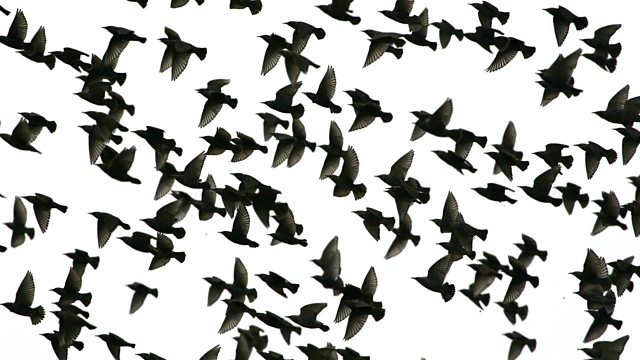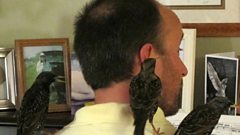Starling
A murmuration of starlings is one of our great British wildlife spectacles and never ceases to inspire and amaze as Brett Westwood discovers in a reed bed on the Somerset Levels.
Every Autumn vast numbers of continental starlings migrate here to take advantage of our milder winters. Huge flocks of up to a million birds or more swirl over their roost sites before settling down for the night. These impressive gatherings, called murmurations, are both remarkable and inspiring as Brett Westwood discovers as he visits a reed bed in Somerset with Tony Whitehead of the RSPB. Brett also gets to grips with the physics of how the birds avoid each other in flight and hears from a sound artist who uses the patterns of starlings on a wire as musical staves. Beethoven was impressed by the starlings ability to mimic his music, while Brett meets a man whose starlings accompany him on the piano.
First broadcast in a longer form on 6th June 2016
Original producer : Sarah Blunt
Archive producer : Andrew Dawes for ΒιΆΉΤΌΕΔ Audio in Bristol.
Last on
Clips
-
![]()
Turning starling pictures into a musical score
Duration: 00:29
-
![]()
Starlings star in piano sing-along
Duration: 01:16
Lloyd Buck

Lloyd's passion for birds began at a very young age and he has been lucky enough to turn it into a long career thanks toΒ an instinctive, intuitive way with the birds.
"Looking after our birds is a not just our career and job, it is a lifestyle, as you have to be there for them seven days a week, but we love it.Β Because we always make sure the birds enjoy themselves, we can get the best out of them without compromising their welfare,β he said.
Kathy Hinde

Drawing inspiration from the natural world, she creates work that is generative; that evolves; that can be different each time it is experienced. Kathy regularly works in collaboration with other practitioners and scientists and often actively involves the audience in the creative process.
In her work 'Piano Migrations'Β the inside of an old upright piano, is recycled into a kinetic sound sculpture and videos of birds are projected directly onto the piano to provide an ever-changing musical score. The movement of the birds trigger small machines to twitch and flutter on the piano strings with nature controlling the machines to create delicate music.
Picture: The inside of of an old upright piano adapted for
Richard Holmes, OBE
He is a Fellow of and a Fellow of the . He was professor of Biographical Studies at the University of East Anglia from 2001β2007 and has honorary doctorates from the University of East London, University of Kingston and the Tavistock Institute. In 1992 he was awarded the Order of the British Empire.
David Matthews

Vincent Sheridan

He was born in County Kildare and studied at the National College of Art and Design, Dublin and the Dublin Institute of Technology.Β From 1989 to 1998 Sheridan lived and worked as an artist in Toronto and Vancouver, CanadaΒ and has spent time in the Canadian High Arctic.Β He returned to Dublin in 1999.
Professor Matthew Turner

In a computer model of a flock, they built up a series of rules based on what each 'bird' would be able to see in front of it.Β The model showed that a flock would naturally tend to form at the tightest density that still allows the birds to see in many directions.Β The team use the term 'Goldilocks' to describe a density that is not too close together, and not too far apart.
Chris Watson

His sound recording career began in 1981 when he joined Tyne Tees Television. Since then he has developed a particular and passionate interest in recording the wildlife sounds of animals, habitats and atmospheres from around the world.
As a freelance recordist for film, TV & radio, he specialises in natural history and documentary location sound together with track assembly and sound design in post-production.
Tony Whitehead

Find out Tony's favourite bird and all about his record label Very Quiet Records in .
Broadcasts
- Tue 6 Jun 2017 11:00ΒιΆΉΤΌΕΔ Radio 4 FM
- Mon 12 Jun 2017 21:00ΒιΆΉΤΌΕΔ Radio 4
- Sun 11 Dec 2022 06:35ΒιΆΉΤΌΕΔ Radio 4




